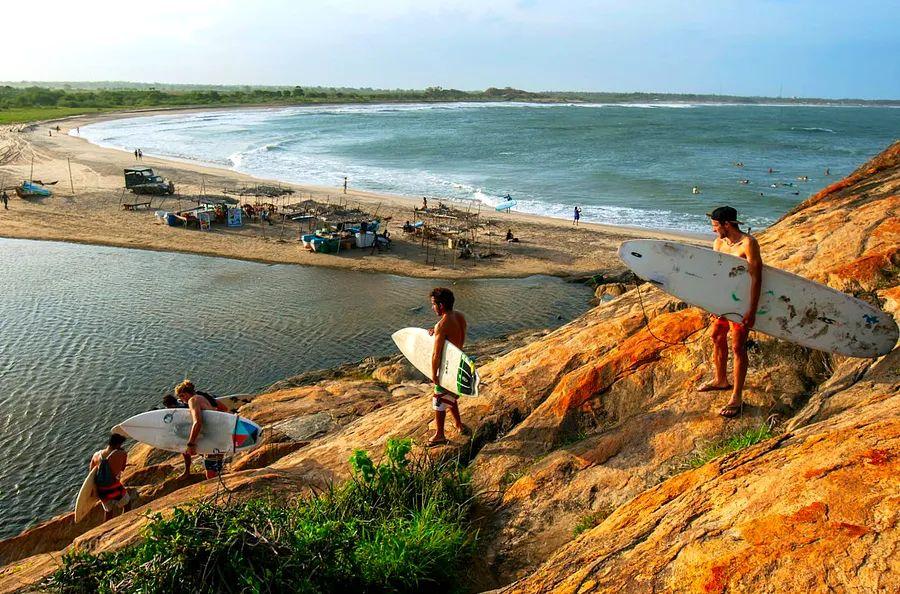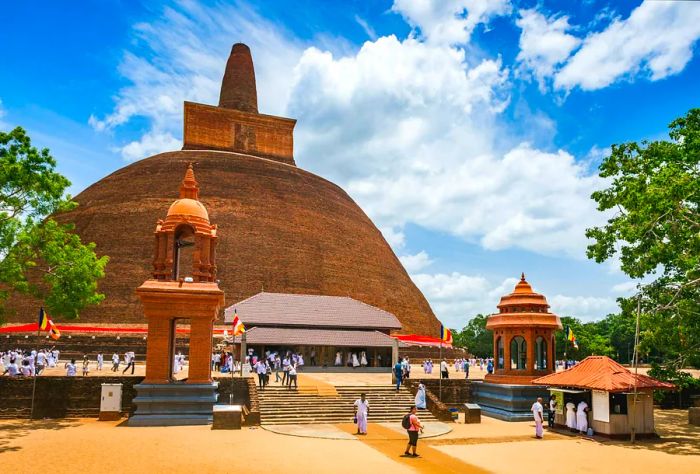When is the ideal time to visit Sri Lanka?

If any destination can be labeled a year-round paradise, it’s Sri Lanka. This compact island features a range of microclimates—while one coastline may be experiencing rain, another could be perfect for surfing or sightseeing.
Situated close to the equator, daytime temperatures remain around 30°C (86°F) throughout the year, so you won’t have to worry much about cold weather, except in the hills. However, it’s essential to consider how the two monsoon seasons impact various regions of the island when planning your visit. Fortunately, it’s easy to navigate across the island if your weather predictions don’t align.
Most travelers blend beach time with excursions to national parks, as well as visits to the cooler highlands and ancient cities located in the island’s center, ensuring a mix of warmth and coolness on almost every trip.
Additionally, the Sri Lankan calendar is filled with festivals and holidays, providing unique cultural experiences for visitors nearly every month. Whether you want to relax on the beach, witness wild elephants, hike up Adam’s Peak, or simply steer clear of the tourist crowds, here are the optimal times to visit Sri Lanka.
The ideal time to enjoy the beach is from December to March
Sri Lanka's peak season aligns with the driest weather in the south and west of the country. Famous beach destinations like Hikkaduwa and Mirissa are at their most beautiful but also their busiest, coinciding with perfect surfing conditions on these coasts. Meanwhile, the Maha monsoon season (October to January) brings humidity and rain to the East, the North, and the Ancient Cities.
Sri Lanka is a fantastic year-round destination for wildlife enthusiasts, but the prime time to see elephants, leopards, and buffalo is during the main tourist season from November to April. All major parks remain open, and animals gather around water holes, making them easier to spot. However, the island’s most remarkable wildlife event—the 'Gathering' of elephants at Minneriya National Park—occurs from July to September.
By December, the high season is in full effect, with beachgoers vying for space on the sands of the south and west coasts. The pilgrimage season on Adam’s Peak also begins in December, attracting pilgrims of all faiths to climb the sacred summit until mid-April.
 Sri Lanka’s peak season can get crowded, but the weather is ideal for sightseeing. extradeda/Shutterstock
Sri Lanka’s peak season can get crowded, but the weather is ideal for sightseeing. extradeda/ShutterstockAs December comes to a close, the island prepares for Christmas, celebrated with great enthusiasm by Sri Lanka’s Christian community. People of other faiths also partake in secular festivities during the holidays—expect extravagant decorations everywhere.
January marks the height of tourist activity in Sri Lanka. While crowds are at their peak and prices soar, the pleasant weather in the south and west makes it an enticing time for a beach getaway, with many popular towns hosting significant festivals throughout the month.
Key events to mark on your calendar include Duruthu Perahera in Colombo, a vibrant festival of lights, dance, and parades celebrating the Buddha's first visit to Sri Lanka. Meanwhile, the quieter annual literary festival in Galle takes over the city’s UNESCO-protected fort.
Visitor numbers remain high in February, as wintering Europeans enjoy the warm beaches. This month is bustling for Sri Lankans, featuring Independence Day celebrations early in the month, marked by festivals, parades, fireworks, and sports events nationwide.
Maha Shivaratri, celebrated in early March (or late February), is a vibrant festival where Hindus honor the union of Shiva and Parvati with all-night vigils and rituals. This is the most significant festival for Shaivite Tamils, who represent the majority of Sri Lanka’s Hindu population.
Ramadan, the Muslim month of fasting, shifts earlier by 11 days each year compared to the Gregorian calendar—beginning in March for 2024 and in February for 2025, during which some Muslim-owned businesses may close during daylight hours.
 Sri Lanka's shoulder seasons provide excellent opportunities for hiking to scenic viewpoints in the Hill Country. Mikhail Sotnikov/Getty Images
Sri Lanka's shoulder seasons provide excellent opportunities for hiking to scenic viewpoints in the Hill Country. Mikhail Sotnikov/Getty ImagesThe optimal times for exploring the entire country are from September to October and in April.
Situated between the two monsoon seasons, Sri Lanka's shoulder seasons offer pleasant weather nationwide, fewer tourists, and lower prices. However, April coincides with the busy Sinhala and Tamil New Year, which may lead to transportation challenges.
This period is ideal for hiking in the Hill Country or climbing Sigiriya, as the weather tends to be dry and not as hot as peak summer. From August to September, Minneriya National Park becomes a gathering place for hundreds of elephants during the annual Gathering, offering a great chance to see baby elephants.
October's weather can be unpredictable, as the Yala monsoon diminishes while conditions shift toward the Maha monsoon. Afternoon thunderstorms and rain are likely, but the east coast still offers good surfing opportunities—just remember to pack a raincoat.
Following the bustling winter season, April brings warm, dry conditions to most of the country, with prices dropping as peak season crowds dissipate. Although Christians make up only six percent of the population, festivals like Easter, typically in April, are celebrated with enthusiasm.
A more prominent celebration in April is Avurudu, the Sinhalese and Tamil New Year. With official holidays on New Year’s Eve and Day, transportation becomes hectic as people travel from cities to their home villages in the days surrounding the holiday.
 The 10-day Esala Perahera festival unleashes a wave of vibrant celebrations throughout Sri Lanka. SamanWeeratunga/Shutterstock
The 10-day Esala Perahera festival unleashes a wave of vibrant celebrations throughout Sri Lanka. SamanWeeratunga/ShutterstockFrom May to August, it’s the ideal time to escape the crowds.
Sri Lanka’s low season kicks off with the Yala monsoon in May, bringing heavy rains to the west and south coasts as well as the Hill Country until August. During this time, accommodation rates drop and tourist numbers decrease.
This period is perfect for visiting Jaffna in the North and enjoying the laid-back resorts along the East Coast, like Arugam Bay, famous for its consistent surf breaks and relaxed atmosphere.
Despite the rainfall, numerous unmissable festivals occur during this time, including Vesak Poya, a two-day celebration in May when vibrant lights illuminate every Buddhist home, shop, and temple. There's also the lively Esala Perahera in Kandy, featuring thousands of dancers and drummers in a grand procession through the streets.
June sees a dip in tourism due to the rains, except along the East Coast beaches, which remain relatively dry. During this time, another significant Buddhist celebration, Poson Poya, unfolds, commemorating the arrival of Buddhism in Sri Lanka. Major festivities occur in the temples of Anuradhapura, where thousands of pilgrims dressed in white ascend the challenging steps to Mihintale’s sacred stupa.
 The Yala monsoon season brings significant celebrations at religious sites like Mihintale. Jonathon Stokes for Dinogo Planet
The Yala monsoon season brings significant celebrations at religious sites like Mihintale. Jonathon Stokes for Dinogo PlanetFor those undeterred by occasional rain, summer is a great time to visit Sri Lanka. The highlight for Buddhists is the Esala Perahera, held in July or August, lasting ten days. The Kandy Esala Perahera is renowned, but smaller parades also take place throughout the country, featuring dancers, drummers, and stilt walkers who train year-round for this event.
In Colombo, a grand procession unfolds as part of the Hindu festival of Aadi Vel, featuring the ceremonial journey of the gilded chariot of Murugan (Skanda), the Hindu god of war, through the bustling city streets.
August signals the conclusion of the low season, with the Yala monsoon gradually subsiding. For a better chance to escape the rain, venture north to Jaffna, where the renowned Nallur Kandaswamy Kovil hosts the spectacular Nallur Festival (sometimes beginning in July). This event culminates in parades of massive floats and intense displays of self-mortification by devoted participants.
 The sacred Sri Maha Bodhi tree is recognized as the oldest known human-planted tree in existence. Boyloso/Shutterstock
The sacred Sri Maha Bodhi tree is recognized as the oldest known human-planted tree in existence. Boyloso/ShutterstockPoya (full moon) days
It's important to note that every poya (full moon) day is a public holiday in Sri Lanka. Pilgrims dressed in white flock to Buddhist shrines, and transportation and accommodations become crowded, particularly when the full moon coincides with a Friday or Monday. Sales of alcohol are generally prohibited on poya days, leading many bars to close (though some hotels may discreetly offer cold beer 'under the table'). This period offers a uniquely spiritual atmosphere, especially at the sacred Sri Maha Bodhi tree in Anuradhapura, which is grown from a cutting of the tree where Buddha achieved enlightenment.

1

2

3

4

5
Evaluation :
5/5